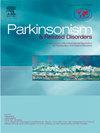Application of elastic net for clinical outcome prediction and classification in progressive supranuclear palsy: A multicenter cohort study
IF 3.1
3区 医学
Q2 CLINICAL NEUROLOGY
引用次数: 0
Abstract
Background
Previous studies have used machine learning to identify clinically relevant atrophic regions in progressive supranuclear palsy (PSP). This study applied Elastic Net (EN) in PSP to uncover key atrophic patterns, offering a novel approach to understanding its pathology.
Methods
This study included baseline data from 74 patients with PSP enrolled in the Study of Comprehensive ANd multimodal marker-based cohort of PSP (SCAN-PSP, NCT05579301) in Seoul between January 2022 and August 2023. Participants were evaluated with PSP-rating scale (PSPRS) and Schwab & England Activity of daily living (SEADL). EN regression was used to identify regions with high explanatory power for clinical outcomes, which were combined with clinical parameters to build prediction models. Features selected from EN classification were applied to discriminate between the two groups.
Results
EN identified the third ventricle, right anterior cingulate cortex, and left lateral orbitofrontal cortex as significant features, and multivariate linear regression models incorporating these regions with clinical variables showed high explainability for PSPRS (adjusted R2 = 0.62) and SEADL (adjusted R2 = 0.74). The EN-predicted values demonstrated strong correlation with actual scores of PSPRS (r = 0.75, p = 2·10−14) and SEADL (r = 0.82, p = 2·10−19). The combined EN-selected features and clinical parameters model robustly distinguished PSP-Richardson from the subcortical types (AUC = 0.94) and those with severe downgaze palsy from without (AUC = 0.90).
Conclusion
This study demonstrated that EN effectively identified significant regional atrophies in PSP, with a modest sample size. Future studies could incorporate multimodal analysis to identify markers for monitoring disease progression.
求助全文
约1分钟内获得全文
求助全文
来源期刊

Parkinsonism & related disorders
医学-临床神经学
CiteScore
6.20
自引率
4.90%
发文量
292
审稿时长
39 days
期刊介绍:
Parkinsonism & Related Disorders publishes the results of basic and clinical research contributing to the understanding, diagnosis and treatment of all neurodegenerative syndromes in which Parkinsonism, Essential Tremor or related movement disorders may be a feature. Regular features will include: Review Articles, Point of View articles, Full-length Articles, Short Communications, Case Reports and Letter to the Editor.
 求助内容:
求助内容: 应助结果提醒方式:
应助结果提醒方式:


